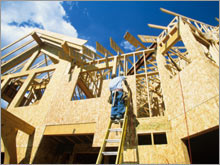Building up, but housing woes far from overHousing starts, permits post surprise gain but weather in the Midwest resulted in false sign of strength.NEW YORK (CNNMoney.com) -- Home building ticked up unexpectedly in March but economists cautioned that a look inside the numbers shows the worst is far from over for the battered housing sector. Housing starts rose to an annual pace of 1.52 million in March, the Census Bureau reported, from a revised 1.51 million rate in February. Economists surveyed by Briefing.com had forecast the pace of building would slow to a 1.5 million rate in March.
Mortgage Rates
But most of the country saw a decline from February's pace of housing starts. The South, which accounts for about half the nation's home building, showed a 3 percent decline, and building fell nearly 8 percent in both the Northeast and West. The exception to that trend was the Midwest, where starts jumped 44 percent in the Midwest after a February reading that was the slowest in 16 years. Bad weather in the region in February and relatively good weather in March probably played a role in the jump, as builders tried to catch up with delayed projects. "The Midwest number is somewhat outlandish," said David Seiders, chief economist for the National Association of Home Builders. "Clearly there were some weather gyrations. We know the region is not in some kind of resurgent mode. "If you hadn't had the number in the Midwest, we would have been down from a February number that was revised lower," said Seiders. "And the March number is still below the original February number." Building permits, often seen as a measure of builders' confidence in the market, edged up to an annual rate of 1.54 million in March from 1.53 million in February. The consensus forecast had been for permits to slow to a 1.52 million rate. Despite the modest growth from February levels, both starts and permits were well below year-ago levels, as starts sank 23 percent and permits tumbled nearly 26 percent. Bill Hampel, chief economist Credit Union National Association, said even with the slight improvement in starts and permits, it may be years too early to call a bottom to the home building market. "I don't think it's going to plummet from here, but the outlook is very modest," he said. "We're going to have trouble beating this number in the next several months. And we may come in 1.4 million or fewer starts for all of 2007." The March report left the pace of building in the first quarter down 5.5 percent from the fourth quarter of 2006, Seiders said, and down 30 percent from year-earlier levels. "The fundamental trend is still slightly downward," he said. "The signals on the demand side of the market are not that reassuring." He said until there is sign of increased demand for new homes, the industry is better off with a relatively weak pace of building because it won't add to the glut of homes on the market. A survey by the National Association of Home Builders released Monday showed that members' confidence fell to a four-month low in April. Problems in the subprime mortgage sector are seen adding to the problem of excess inventories of new homes. The glut of new homes for sale on the market has slammed sales and profits of the nation's major builders. D.R. Horton (Charts), the nation's No. 2 home builder, reported last week that the number of new homes it sold in its fiscal second quarter sank nearly 37 percent, as it said it has yet to see the normal start of the spring home buying season. No. 3 builder Pulte Homes (Charts) reported a loss in its most recent period, as did No. 4 Centex (Charts) and New Jersey-based Hovnanian Enterprises (Charts). No. 1 builder Lennar (Charts) and No. 5 KB Home (Charts) both reported losses in their quarters ending in November, although both returned to an operating profit in their most recent period. |
Sponsors
|

